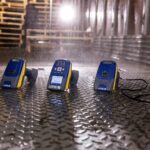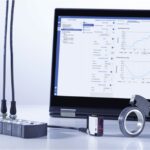Jacek Smoluch, Mitsubishi Electric’s Robot Product Leader CEE, on what’s next in 2025
The industrial sector is at a crossroads. As the world demands greener manufacturing processes, businesses integrate innovative technologies to remain competitive. Artificial intelligence (AI), robotics, and sustainable innovations are not just buzzwords—they’re now the backbone of modern industry.
Deep dive into the future of the manufacturing landscape
In an interview with Jacek Smoluch, Mitsubishi Electric’s Robot Product Leader in the CEE region and a specialist in industrial automation, we’ll talk about the trends, challenges, and opportunities facing the industry in 2025. What barriers are hindering progress, and what trends will shape the future of industrial automation? We invite you to read an interview where the expert shares his knowledge and experience.

Jacek Smoluch, Mitsubishi Electric’s Robot Product Leader CEE.
Question: 2024 was a year of rapid advancements in technology and sustainability. From your perspective, what stood out the most for the manufacturing sector?
Jacek Smoluch: Last year felt like a tipping point. AI moved from being a futuristic idea to a practical tool that’s solving real problems. Companies began using AI to optimise energy consumption, reduce waste, and streamline operations. It wasn’t about theories or pilot programmes anymore — it was about real execution with measurable results. I also saw a fundamental mindset shift. Sustainability went from being a “nice-to-have” to a central business objective. It’s no longer just about meeting regulations; customers, employees, and stakeholders are actively demanding greener and more responsible operations. Moreover, new EU directives and regulations, such as the Regulation (EU) 2024/3005 on ESG ratings, are pushing sustainability from a ‘nice-to-have’ to a mandatory aspect of business operations, especially in the manufacturing sector. If 2024 was the year of awakening, 2025 is the year I see before these priorities fully integrated into everyday manufacturing strategies.
Question: Sustainability is clearly at the forefront. How are new technologies helping manufacturers achieve their environmental goals?
Jacek Smoluch: I am seeing significant progress, but I still have a way to go. AI is playing a pivotal role in energy management and resource optimisation. Think of it like a factory brain—it monitors equipment, analyses performance data in real time, and adjusts operations to reduce energy waste. For instance, advanced monitoring systems like our EcoAdviser are revolutionizing how we track and optimize resource usage. These solutions can automatically identify energy losses across all utilities—from electricity to water and gas—and suggest immediate improvements. With Digital Twin technology, we can test and refine processes in a virtual environment, minimising waste before any physical changes are made. Combined with energy-efficient innovations like permanent magnet synchronous salient-pole motors like the EM-A series, which significantly reduce power consumption while maintaining high precision, these solutions are making sustainability both achievable and profitable. That said, one of the key challenges is accessibility. While larger manufacturers are often at the forefront of this technological transformation, smaller ones may have different considerations, such as balancing investment costs with day-to-day operations. By fostering more accessible, user-friendly tools that can scale across the sector, we can create opportunities for businesses of all sizes to embrace smarter manufacturing.
Question: AI clearly has massive potential. What applications do you think will dominate in 2025?
Jacek Smoluch: Predictive maintenance is definitely one to watch. With AI, we can now predict equipment failures before they occur — saving time, money, and resources. It’s like knowing your car needs an oil change before the warning light even comes on. Another area is logistics. AI doesn’t just optimise warehouse space or delivery schedules. It transforms supply chains into well-oiled, efficient systems. Imagine eliminating unnecessary routes or perfectly timing shipments to reduce idle inventory. That’s AI at work. Of course, there’s also a growing emphasis on combining AI with human expertise.
Question: Could you point to some practical examples of these solutions in action?
Jacek Smoluch: At Mitsubishi Electric, for example, we focus on solutions like MaiLab. This platform doesn’t replace human decision-making but complements it by turning complex production data into actionable insights. It helps teams make smarter decisions, faster, and ensures that operational know-how is preserved and passed on. Mitsubishi Electric has been investing in digital technologies for years. We are experts in digital manufacturing, digital twins, AI in quality control, and energy monitoring. Mitsubishi Electric offers leading, comprehensive solutions for Industry 4.0, providing real added value to customers.
Question: With all these advancements, why aren’t we seeing more widespread adoption of AI?
Jacek Smoluch: The benefits are obvious, but adoption isn’t without hurdles. Cost is one factor. AI is often perceived as expensive, especially for smaller firms. Complexity is another. There’s often a common misconception that implementing AI requires overhauling entire systems or hiring specialists. A potential solution could be starting small. Focus on solving one problem — like reducing waste or improving production efficiency — and build from there. Small wins lead to big transformations, step by step.
Question: Robotics is another hot topic. Humanoid robots often steal the spotlight, but what’s their actual role in manufacturing?
Jacek Smoluch: Ah, humanoids—the poster children of robotics! We have this awesome privilege of watching something new come to life right before our eyes. A new type of robot that, in just a few years, will be as common as coffee machines or robot vacuums. Sure, right now their performance and practical use in manufacturing is limited, but we have to remember that we’re only at the start of their journey, and I really believe that in a few years they’ll be a normal part of the industry, and in a decade they’ll be all around us in everyday life.
Getting back to manufacturing, traditional industrial robots and cobots have a huge edge when it comes to precision, repeatability, and speed—things that are key for robots. Whether it’s assembling parts, welding, or packaging, these robots rock at tasks that need speed and accuracy. However, I wouldn’t separate the two. In my opinion, humanoids and industrial robots will coexist in the industry as solutions that keep production running—each simply doing a different job. It’s just like having a wrench to turn a bolt instead of always using your hand—you gotta find the right tool for the job.
Question: With so much change on the horizon, where do you see the industry heading in the next few years?
Jacek Smoluch: Two major shifts are reshaping manufacturing: First, we’re seeing unprecedented integration of AI, robotics, and connected devices—transforming factories from isolated systems into seamlessly orchestrated operations. Second, sustainability is becoming inseparable from innovation, with AI driving both efficiency and environmental goals. It’s no longer about choosing between profitability and responsibility—they’re becoming one and the same. I envision a future where technology supports and empowers, seamlessly integrating into existing processes rather than disrupting them. AI will become as essential as electricity in factories, with robotics and connected systems creating more intuitive operations. Its significance is particularly crucial now, as industries face growing labour shortages and knowledge retention challenges. By capturing and transferring expertise from experienced workers to new generations, AI helps bridge the skills gap and ensures critical operational knowledge isn’t lost as workforce demographics shift. But the real change isn’t just technological—it’s cultural. Companies that understand how to blend innovation with sustainability won’t just survive; they’ll shape the industry’s future.
The technology is ready, and the opportunities are immense
The future of industrial automation clearly depends on AI. Instead of being intimidated by the cost and complexity of cloud-based AI, factories should focus on bringing AI directly onto their factory floors. This means building AI into the machines and devices already in use. This approach is more affordable, easier to manage, and addresses many of the current roadblocks to using AI. By making individual machines smarter, factories can benefit from improved efficiency, predictive maintenance, and a more autonomous production process. This factory-focused approach to AI could be essential for companies that want to succeed in the changing world of Industry 4.0.
Trends in Manufacturing: 2025 and beyond | Mitsubishi Electric – YouTube
To learn more about Mitsubishi Electric, please visit: Mitsubishi Electric Factory Automation – EMEA







